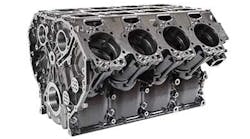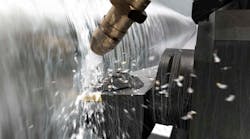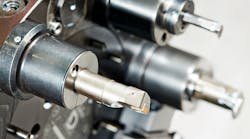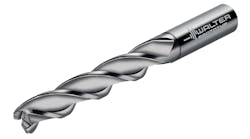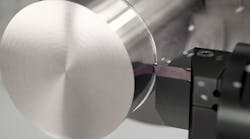The condition and physical properties of the work material have a direct influence on the machinability of a work material. The various conditions and characteristics described as "condition of work material," individually and in combinations, directly influence and determine the machinability. Operating conditions, tool material and geometry and workpiece requirements exercise indirect effects on machinability and can often be used to overcome difficult conditions presented by the work material. On the other hand, they can create situations that increase machining difficulty if they are ignored.
Condition of Work Material
The following eight factors determine the condition of the work material: microstructure, grain size, heat treatment, chemical composition, fabrication, hardness, yield strength and tensile strength.
Microstructure: The microstructure of a metal refers to its crystal or grain structure as shown through examination of etched and polished surfaces under a microscope. Metals whose microstructures are similar have like machining properties. But there can be variations in the microstructure of the same workpiece that will affect machinability.
Grain Size: Grain size and structure of a metal serve as general indicators of its machinability. A metal with small undistorted grains tends to cut easily and finish easily. Such a metal is ductile, but it is also "gummy." Metals of an intermediate grain size represent a compromise that permits both cutting and finishing machinability. Hardness of a metal must be correlated with grain size and it is generally used as an indicator of machinability.
Heat Treatment: To provide desired properties in metals, they are sometimes put through a series of heating and cooling operations when in the solid state. A material may be treated to reduce brittleness, remove stress, to obtain ductility or toughness, to increase strength, to obtain a definite microstructure, to change hardness or to make other changes that affect machinability.
Chemical Composition: Chemical composition of a metal is a major factor in determining its machinability. The effects of composition though, are not always clear, because the elements that make up an alloy metal, work both singly and collectively. Certain generalizations about chemical composition of steels in relation to machinability can be made, but nonferrous alloys are too numerous and varied to permit such generalizations.
Fabrication: Whether a metal has been hot rolled, cold rolled, cold drawn cast, or forged will affect its grain size, ductility, strength, hardness, structure-and therefore-its machinability.
The term "wrought" refers to the hammering or forming of materials into premanfactured shapes which are readily altered into components or products using traditional manufacturing techniques. Wrought metals are defined as that group of materials, which are mechanically shaped into, bars, billets, rolls, sheets, plates or tubing.
Casting involves pouring molten metal into a mold to arrive at a near component shape that requires minimal, or in some cases no machining. Molds for these operations are made from sand, plaster, metals and a variety of other materials.
Hardness: The textbook definition of hardness is the tendency for a material to resist deformation. Hardness is often measured using either the Brinell or Rockwell scale. The method used to measure hardness involves embedding a specific size and shaped indenter into the surface of the test material, using a predetermined load or weight. The distance the indenter penetrates the material surface will correspond to a specific Brinell or Rockwell hardness reading. The greater the indenter surface penetration, the lower the ultimate Brinell or Rockwell number, and thus the lower the corresponding hardness level. Therefore, high Brinell or Rockwell numbers or readings represent a minimal amount of indenter penetration into the workpiece and thus, by definition, are an indication of an extremely hard part. Figure 3.1 shows how hardness is measured. 600
The Brinell hardness test involves embedding a steel ball of a specific diameter, using a kilogram load, in the surface of a test piece. The Brinell Hardness Number (BHN) is determined by dividing the kilogram load by the area (in square millimeters) of the circle created at the rim of the dimple or impression left in the workpiece surface. This standardized approach provides a consistent method to make comparative tests between a variety of workpiece materials or a single material that has undergone various hardening processes.
The Rockwell test can be performed with various indenter sizes and loads. Several different scales exist for the Rockwell method or hardness testing. The three most popular are outlined below in terms of the actual application the test is designed to address:
Yield Strength: Tensile test work is used as a means of comparison of metal material conditions. These tests can establish the yield strength, tensile strength and many other conditions of a material based on its heat treatment. In addition, these tests are used to compare different workpiece materials. The tensile test involves taking a cylindrical rod or shaft and pulling it from opposite ends with a progressively larger force in a hydraulic machine. Prior to the start of the test, two marks either two or eight inches apart are made on the rod or shaft. As the rod is systematically subjected to increased loads, the marks begin to move farther apart. A material is in the so-called `elastic zone' when the load can be removed from the rod and the marks return to their initial distance apart of either two or eight inches. If the test is allowed to progress, a point is reached where, when the load is removed, the marks will not return to their initial distance apart. At this point, permanent set or deformation of the test specimen has taken place.
Yield strength is measured just prior to the point before permanent deformation takes place. Yield strength is stated in pounds per square inch (PSI) and is determined by dividing the load just prior to permanent deformation by the cross sectional area of the test specimen. This material property has been referred to as a condition, since it can be altered during heat treatment. Increased part hardness produces an increase in yield strength and therefore, as a part becomes harder, it takes a larger force to produce permanent deformation of the part. Yield strength should not be confused with fracture strength, cracking or the actual breaking of the material into pieces, since these properties are quite different and unrelated to the current subject.
Tensile Strength: The tensile strength of a material increases along with yield strength as it is heat treated to greater hardness levels. This material condition is also established using a tensile test. Tensile strength (or ultimate strength) is defined as the maximum load that results during the tensile test, divided by the cross-sectional area of the test specimen. Therefore, tensile strength, like yield strength, is expressed in PSI. This value is referred to as a material condition rather than a property, since its level just like yield strength and hardness, can be altered by heat treatment. Therefore, based on the material selected, distinct tensile and yield strength levels exist for each hardness reading.
Physical Properties of Work Materials
Physical properties will include those characteristics included in the individual material groups, such as the modulus of elasticity, thermal conductivity, thermal expansion and work hardening.
Modulus of Elasticity: The modulus of elasticity can be determined during a tensile test in the same manner as the previously mentioned conditions.
However, unlike hardness, yield or tensile strength, the modulus of elasticity is a fixed material property and, therefore, is unaffected by heat treatment. This particular property is an indicator of the rate at which a material will deflect when subjected to an external force. This property is stated in PSI and typical values are several million PSI for metals.
Hardness is measured by depth of indentations made.
Thermal Conductivity: Materials are frequently labeled as being either heat conductors or insulators. Conductors tend to transfer heat from a hot or cold object at a high rate, while insulators impede the flow of heat. Thermal conductivity is a measure of how efficiently a material transfers heat. Therefore, a material that has a relatively high thermal conductivity would be considered a conductor, while one with a relatively low level would be regarded as an insulator.
Thermal Expansion: Many materials, especially metals, tend to increase in dimensional size as their temperature rises. This physical property is referred to as thermal expansion. The rate at which metals expand varies, depending on the type or alloy of material under consideration. The rate at which metal expands can be determined using the material's expansion coefficient. The greater the value of this coefficient, the more a material will expand when subjected to a temperature rise or contract when subjected to a temperature reduction. For example, a 100- bar of steel which encounters a 100 F rise in temperature would measure 100.065-.
Work Hardening: Many metals exhibit a physical characteristic that produces dramatic increases in hardness due to cold work. Cold work involves changing the shape of a metal object by bending, shaping, rolling or forming. As the metal is shaped, internal stresses develop which act to harden the part. The rate and magnitude of this internal hardening varies widely from one material to another. Heat also plays an important role in the work hardening of a material. When materials that exhibit work hardening tendencies are subjected to increased temperature, it acts like a catalyst to produce higher hardness levels in the workpiece.
Metal Machining
The term "machinability" is a relative measure of how easily a material can be machined when compared to 160 Brinell AISI B 1112 free machining low carbon steel. The American Iron and Steel Institute (AISI) ran turning tests of this material at 180 surface feet and compared their results for B 1112 against several other materials. If B 1112 represents a 100% rating, then materials with a rating less than this level would be decidedly more difficult to machine, while those that exceed 100% would be easier to machine.
The machinability rating of a metal takes the normal cutting speed, surface finish and tool life attained into consideration. These factors are weighted and combined to arrive at a final machinability rating. The following chart shows a variety of materials and their specific machinability ratings:
Cast Iron
All metals that contain iron (Fe) are known as ferrous materials. The word "ferrous" is by definition, "relating to or containing iron." Ferrous materials include cast iron, pig iron, wrought iron, and low carbon and alloy steels. The extensive use of cast iron and steel workpiece materials can be attributed to the fact that iron is one of the most frequently occurring elements in nature.
When iron ore and carbon are metallurgically mixed, a wide variety of workpiece materials result with a fairly unique set of physical properties. Carbon contents are altered in cast irons and steels to provide changes in hardness, yield and tensile strengths. The physical properties of cast irons and steels can be modified by changing the amount of the iron-carbon mixtures in these materials as well as their manufacturing process.
Pig iron is created after iron ore is mixed with carbon in a series of furnaces. This material can be changed further into cast iron, steel or wrought iron depending on the selected manufacturing process.
Cast iron is an iron carbon mixture that is generally used to pour sand castings, as opposed to making billets or bar stock. It has excellent flow properties and therefore, when it is heated to extreme temperatures, is an ideal material for complex cast shapes and intricate molds. This material is often used for automotive engine blocks, cylinder heads, valve bodies, manifolds, heavy equipment oil pans and machine bases.
Gray Cast Iron: Gray cast iron is an extremely versatile, very machinable relatively low strength cast iron used for pipe, automotive engine blocks, farm implements and fittings. This material receives its dark gray color from the excess carbon in the form of graphite flakes, which give it its name.
White Cast Iron: White cast iron occurs when all of the carbon in the casting is combined with iron to form cementite. This is an extremely hard substance that results from the rapid cooling of the casting after it is poured. Since the carbon in this material is transformed into cementite, the resulting color of the material when chipped or fractured is a silvery white. Thus the name white cast iron. However, white cast iron has almost no ductility, and therefore when it is subjected to any type of bending or twisting loads, it fractures. The hard brittle white cast iron surface is desirable in those instances where a material with extreme abrasion resistance is required. Applications of this material would include plate rolls in a mill or rock crushers.
Yield strength is measured by pulling a test specimen as shown.
Malleable Cast Iron: When white cast iron castings are annealed (softened by heating to a controlled temperature for a specific length of time), malleable iron castings are formed. Malleable iron castings result when hard, brittle cementite in white iron castings is transformed into tempered carbon or graphite in the form of rounded nodules or aggregate. The resulting material is a strong, ductile, tough and very machinable product that is used on a broad scope of applications.
Nodular Cast Iron: Nodular or "ductile" iron is used to manufacture a wide range of automotive engine components including cam shafts, crank shafts, bearing caps and cylinder heads. This material is also frequently used for heavy equipment cast parts as well as heavy machinery faceplates and guides. Nodular iron is strong, ductile, tough and extremely shock resistant.
Steel
Steel materials are comprised mainly of iron and carbon, often with a modest mixture of alloying elements. The biggest difference between cast iron materials and steel is the carbon content. Cast iron materials are compositions of iron and carbon, with a minimum of 1.7 percent carbon to 4.5 percent carbon. Steel has a typical carbon content of .05 percent to 1.5 percent.
The commercial production of a significant number of steel grades is further evidence of the demand for this versatile material. Very soft steels are used in drawing applications for automobile fenders, hoods and oil pans, while premium grade high strength steels are used for cutting tools. Steels are often selected for their electrical properties or resistance to corrosion. In other applications, non-magnetic steels are selected for wrist watches and minesweepers.
Plain Carbon Steel: This category of steels includes those materials that are a combination of iron and carbon with no alloying elements. As the carbon content in these materials is increased, the ductility (ability to stretch or elongate without breaking) of the material is reduced. Plain carbon steels are numbered in a four-digit code according to the AISI or SAE system (i.e. 10XX). The last two digits of the code indicate the carbon content of the material in hundredths of a percentage point. For example, a 10 18 steel has a 0.18-percent carbon content.
Alloy Steels: Plain carbon steels are made up primarily of iron and carbon, while alloy steels include these same elements with many other elemental additions. The purpose of alloying steel is either to enhance the material's physical properties or its ultimate manufacturability. The physical property enhancements include improved toughness, tensile strength, hardenability, (the relative ease with which a higher hardness level can be attained), ductility and wear resistance. The use of alloying elements can alter the final grain size of a heat-treated steel, which often results in a lower machinability rating of the final product. The primary types of alloyed steel are: nickel, chromium, manganese, vanadium, molybdenum, chrome-nickel, chrome-vanadium, chrome-molybdenum, and nickel-molybdenum.
Tool Steels: This group of high strength steels is often used in the manufacture of cutting tools for metals, wood and other workpiece materials. In addition, these high-strength materials are used as die and punch materials due to their extreme hardness and wear resistance after heat treatment. The key to achieving the hardness, strength and wear-resistance desired for any tool steel is normally through careful heat treatment. These materials are available in a wide variety of grades with a substantial number of chemical compositions designed to satisfy specific as well as general application criteria.
Stainless Steels: As the name implies, this group of materials is designed to resist oxidation and other forms of corrosion, in addition to heat in some instances. These materials tend to have significantly greater corrosion resistance than their plain or alloy steel counterparts due to the substantial additions of chromium as an alloying element. Stainless steels are used extensively in the food processing, chemical and petroleum industries to transfer corrosive liquids between processing and storage facilities. Stainless steels can be cold formed, forged, machined, welded or extruded. This group of materials can attain relatively high strength levels when compared to plain carbon and alloy steels. Stainless steels are available in up to 150 different chemical compositions. The wide selection of these materials is designed to satisfy the broad range of physical properties required by potential customers and industries. Stainless steels fall into four distinct metallurgical categories. These categories include: austenitic, ferritic, martensitic, and precipitation hardening.
Nonferrous Metals and Alloys
Nonferrous metals and alloys cover a wide range of materials from the more common metals such as aluminum, copper, and magnesium, to high-strength high-temperature alloys such as tungsten, tantalum and molybdenum. Although more expensive than ferrous metals, nonferrous metals and alloys have important applications because of their numerous properties, such as corrosion resistance, high thermal and electrical conductivity, low density, and ease of fabrication. Tools.
Judging Machinability
The factors affecting machinability have been explained; four methods used to judge machinability are discussed below:
Tool Life: Metals that can be cut without rapid tool wear are generally thought of as being quite machinable, and vice versa. A workpiece material with many small hard inclusions may appear to have the same mechanical properties as a less abrasive metal. It may require no greater power consumption during cutting. Yet, the machinability of this material would be lower because its abrasive properties are responsible for rapid wear on the tool, resulting in higher machining costs.
One problem arising from the use of tool life as a machinability index is its sensitivity to the other machining variables. Of particular importance is the effect of tool material. Machinability ratings based on tool life cannot be compared if a high-speed steel tool is used in one case and a sintered carbide tool in another. The superior life of the carbide tool would cause the machinability of the metal cut with the steel tool to appear unfavorable. Even if identical types of tool materials are used in evaluating the workpiece materials, meaningless ratings may still result. For example, cast iron cutting grades of carbide will not hold up when cutting steel because of excessive cratering, and steel cutting grades of carbide are not hard enough to give sufficient abrasion resistance when cutting cast iron.
Tool life may be defined as the period of time that the cutting tool performs efficiently. Many variables such as material to be machined, cutting tool material, cutting tool geometry, machine condition, cutting tool clamping, cutting speed, feed, and depth of cut, make cutting tool life determination very difficult.
The first comprehensive tool life data were reported by EW. Taylor in 1907, and his work has been the basis for later studies. Taylor showed that the relationship between cutting speed and tool life can be expressed empirically by: VT = C
where: V = cutting speed, in feet per minute
T = tool life, in minutes
C= a constant depending on work material, and other machine variables.
Numerically it is the cutting speed which would give 1 minute of tool life.
n = a constant depending on work and tool material.
This equation predicts that when plotted on log-log scales, there is a linear relationship between tool life and cutting speed. The exponent n has values ranging from 0.125 for high-speed steel (HSS) tools, to 0.70 for ceramic tools.
Tool Forces and Power Consumption: The use of tool forces or power consumption as a criterion of machinability of the workpiece material comes about for two reasons. First, the concept of machinability as the ease with which a metal is cut implies that a metal through which a tool is easily pushed should have a good machinability rating. Second, the more practical concept of machinability in terms of minimum cost per part machined, relates to forces and power consumption, and the overhead cost of a machine of proper capacity.
When using tool forces as a machinability rating, either the cutting force or the thrust force (feeding force) may be used. The cutting force is the more popular of the two since it is the force that pushes the tool through the workpiece and determines the power consumed. Although machinability ratings could be listed according to the cutting forces under a set of standard machining conditions, the data are usually presented in terms of specific energy. Workpiece materials having a high specific energy of metal removal are said to be less machinable than those with a lower specific energy.
The use of net power consumption during machining as an index of the machinability of the workpiece is similar to the use of cutting force. Again, the data are most useful in terms of specific energy. One advantage of using specific energy of metal removal as an indication of machinability, is that it is mainly a property of the workpiece material itself and is quite insensitive to tool material. By contrast, tool life is strongly dependent on tool material.
The metal removal factor is the reciprocal of the specific energy and can be used directly as a machinability rating if forces or power consumption are used to define machinability. That is, metals with a high metal removal factor could be said to have high machinability.
Cutting tool forces were discussed in Chapter 2. Tool force and power consumption formulas and calculations are beyond the scope of this article; they are discussed in books that are more theoretical in their approach to discussing machinability of metals.
Surface Finish: The quality of the surface finish left on the workpiece during a cutting operation is sometimes useful in determining the machinability rating of a metal. Some workpieces will not `take a good finish' as well as others. The fundamental reason for surface roughness is the formation and sloughing off of parts of the built-up edge on the tool. Soft, ductile materials tend to form a built-up edge rather easily. Stainless steels, gas turbine alloy and other metals with high strain hardening ability also tend to machine with built-up edges. Materials which machine with high shear zone angles tend to minimize built-up edge effects. These include the aluminum alloys, cold worked steels, free-machining steels, brass and titanium alloys. If surface finish alone were the chosen index of machinability, these latter metals would rate higher than those in the first group.
In many cases, surface finish is a meaningless criterion of workpiece machinability. In roughing cuts, for example, no attention to finish is required. In many finishing cuts, the conditions producing the desired dimension on the part will inherently provide a good finish within the engineering specification.
Machinability figures based on surface finish measurements do not always agree with figures obtained by force or tool life determinations. Stainless steels would have a low rating by any of these standards, while aluminum alloys would be rated high. Titanium alloys would have a high rating by finish measurements, low by tool life tests, and intermediate by force readings.
The machinability rating of various materials by surface finish are easily determined. Surface finish readings are taken with an appropriate instrument after standard workpieces of various materials are machined under controlled cutting conditions. The machinability rating varies inversely with the instrument reading. A low reading means good finish, and thus high machinability. Relative ratings may be obtained by comparing the observed value of surface finish with that of a material chosen as the reference.
Chip Form: There have been machinability ratings based on the type of chip that is formed during the machining operation. The machinability might be judged by the ease of handling and disposing of chips. A material that produces long stringy chips would receive a low rating, as would one, which produces fine powdery chips. Materials, which inherently form nicely broken, chips, a half or full turn of the normal chip helix, would receive top rating. Chip handling and disposal can be quite expensive. Stringy chips are a menace to the operator and to the finish on the freshly machined surface. However, chip formation is a function of the machine variables as well as the workpiece material, and the ratings obtained by this method could be changed by provision of a suitable chip breaker.
Ratings based on the ease of chip disposal are basically qualitative, and would be judged by an individual who might assign letter gradings of some kind. Wide use is not made of this method of interpreting machinability. It finds some application in drilling, where good chip formation action is necessary to keep the chips running up the flutes. However, the whipping action of long coils once they are clear of the hole is undesirable. Chip formation and tool wear were discussed in Chapter 2.
George Schneider, Jr., is the author of Cutting Tool Applications, a handbook to machine tool materials, principles, and designs. He is the Professor Emeritus of Engineering Technology at Lawrence Technological University, and former Chairman of the Detroit Chapter of the Society of Manufacturing Engineers.



